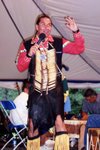
"Old Man was sittin by the creek gazing into the water when a reflection of a branch of dark ripe choke cherries caught his attention. Old Bear was sittin close by watching the Old Man enjoy the summer sweetened berries. "Go ahead, you can have those berries down there" Old Man said pointing to the relection in the green hole. Old Man laughed as Bear dove in."
Have you ever noticed Indians are always expecting something really good only to discover broken promises? The story of "Old Man" contains elements of deception, gullibility, greed and unfulfilled expectations all too familiar to Indian people. Indians have been doped into believing that the maintenance of a high degree of Indian blood among members will protect tribal soveriegnty, guarantee federal treaty rights, and increase their share of payouts. Indian tribes zealous to protect land base and soveriegnty have adopted racist policies that has resulted in the loss of future generations. Blood quantum enrollment requirments is institutionalized bigoty and has poisoned the American Indian psyche with a racist under-current. Tribal populations have become infested with prejudice and discrimination toward their own children and have left a generation of youth with no identity. Shame, shame! Native people are quick to accuse White people of racism but are blind to the fact they are resposible for racism and bigotry toward their own children.
Who is or what is an Indian? There are four basic ways Indians have been defined. First through blood quantum - the cut off is established by individual tribes, and is restricted to those meeting enrollment criteria, 1/4, 1/2, 1/16 etc. Secondly, the federal government define Indian as a person with at least one quarter degree Indian blood or is a member of a federally recognized tribe. Thirdly, lineal descent is described as being anyone who has an ancestor who was a full blood member of a tribe. The fourth way is subjective identification or a person who believes they are Indian, whose friends believe they are Indian, are considered Indian by the white community and are accepted by the Indian community. These synthetic definitions don't come close to defining what an Indian is; they fail to describe the emotional and cultural bonding that occurs when one is born into an Indian community. Tribal ancestors were much wiser in determining membership; they were more concerned with the well being of their children and the perpetuation of the tirbe then with artificial cut off numbers. Being Indian was a matter of kinship and family bonding, a common ancestory and a shared history. A tribal elder would never consider severing their children from their linage.
Membership in communtiy is the right of every person born within an ethnic group and they have the right to lay claim to the history, traditions, heritage, symbols, and land of its people. I propose that it is the parents and the culture a child is born into who determinies ethnicity. Citizenship is not deterined by the division of blood but belonging to family and culture, and choosing to participate as a citizen. Our ancestors practiced inclusion. Membership was based upon an individuals right to lay claim to the community, culture and language of their people and not by division of blood. This guiding principle kept tribes strong and population growth guaranteed protection against other tribes. The ancestors never referred to ones blood degree, nor were they concerned with purity of race, but a stong cultural base was maintained through tradition.
A vision for a generation of Native people thriving in a global community in the Twenty First Century must emerge. A new definition must emerge in a new imaginative way linked to the wisdom of the past. Tribal leaders must reject policies born out of fear and prejudice by embracing descendents and instilling Indianness into the culture. A visionalry leadership will assure a futute for its members.
